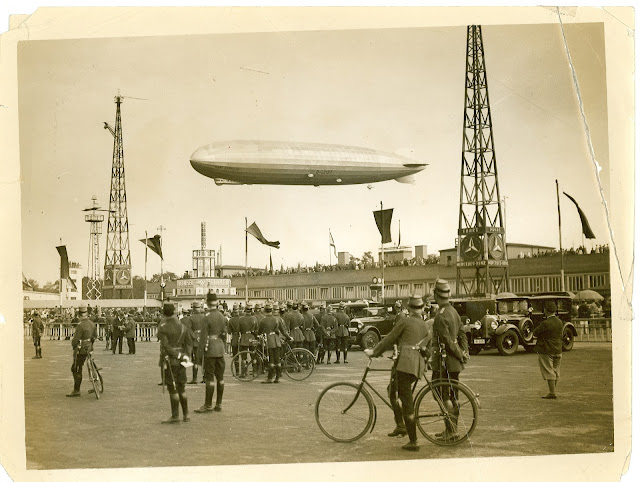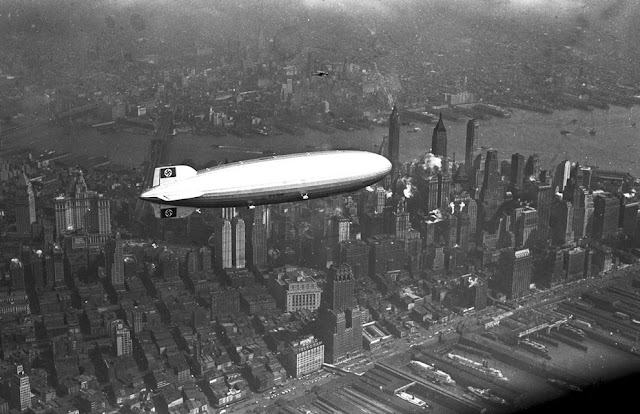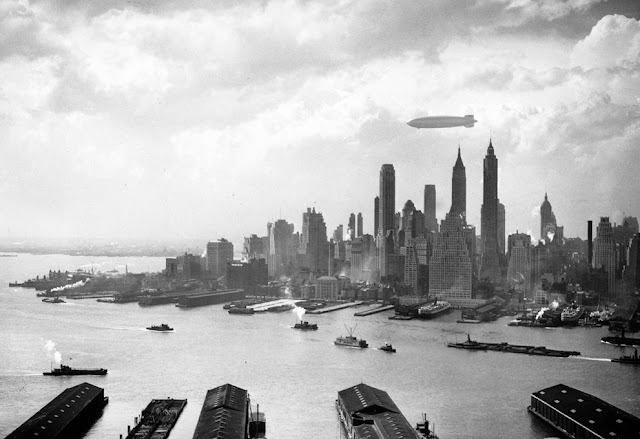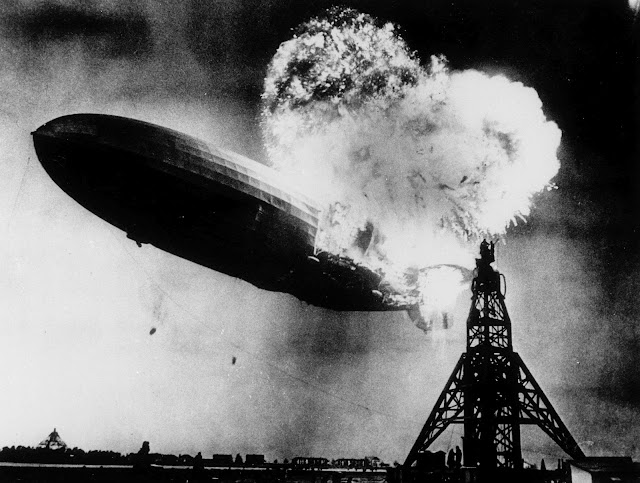On 6 May 1937, took place a tragedy, caught on film, that haunted the American consciousness for decades.
"The heat was so great that it burned my eyebrows all the way off. ... It has been in my memory forever. It's one of those things you can't forget." ~ Photographer Fred Bamberger
On the rainy day of May 6th, 1937 after working the graveyard shift, Fred Bamberger went to Lakehurst Naval Station in New Jersey. The Hindenburg was expected to land at 7:00 a.m. Lacking an adequate number of active personnel to assist in the landing of the Hindenburg, the local townspeople would be paid $1/hour to help pull down the Zepplins ropes.
The Hindenburg's landing would be scheduled at either 7:00 a.m or 7:00 p. m., to fit within the work schedules of the townspeople. Fighting winds all day, the Hindenburg attempted to land at 7:33 p.m. Photographer Fred Bamberger positioned himself one mile away, so he could get the entire Hindenburg in frame. When Fred looked up, he noticed a streak of fire above the fin of the Zepplin.
Bamberger put his speed graphic camera to his eye and began photographing. Because of the rain, his camera locked up. Quickly reacting, Fred reached underneath his jacket and whipped out his Zeiss Contax 35mm camera. Witnessing the massive explosion, Fred continued to photograph as the Hindenburg crashed to the ground.
The explosion was so powerful Fred's eyebrows were burned off his face from the hydrogen that kept fueling the burning Zepplin. Shocked in disbelief, Fred moved closer. As he was approaching, he saw people jumping out of the Hindenburg, trying to escape.

The steel skeleton of "LZ 129", the new German airship, under construction in Friedrichshafen. The airship would later be named after the late Field Marshal Paul von Hindenburg, former President of Germany.
Spectators and ground crew surround the gondola of the Hindenburg as the lighter-than-air ship prepares to depart the U.S. Naval Station at Lakehurst, New Jersey, on May 11, 1936, on a return trip to Germany.
he Hindenburg dumps water to ensure a smoother landing in Lakehurst, New Jersey, on May 9, 1936. The airship made 17 round trips across the Atlantic Ocean in 1936, transporting 2,600 passengers in comfort at speeds up to 135 km/h (85 mph). The Zeppelin Company began constructing the Hindenburg in 1931, several years before Adolf Hitler's appointment as German Chancellor. For the 14 months it operated, the airship flew under the newly-changed German national flag, the swastika flag of the Nazi Party.+airship+of+the+Zeppelin+Transport+Comnpany+landing+at+airship+port+upon+return+from+commercial+flight+to+England+1936.jpeg)

A U.S. Coast Guard plane escorts the Hindenburg to a landing at Lakehurst, New Jersey, on its inaugural flight between Freidrichshafen and Lakehurst in 1936.(US Coast Guard)

The Hindenburg flies over the Boston Common in Boston, Massachusetts in 1936. Another small plane can also be seen at top right.
Interior of the lounge aboard the Hindenburg, where passenger windows could be opened.(Nationaal Archief/Spaarnestad Photo)
An unidentified woman survivor is led from the scene of the Hindenburg disaster at the U.S. Naval Station in Lakehurst, New Jersey, on May 6, 1937.(AP Photo/Murray Becker)
German soldiers give the salute as they stand beside the casket of Capt. Ernest A. Lehmann, former commander of the zeppelin Hindenburg, during funeral services held on the Hamburg-American pier in New York City, on May 11, 1937. The swastika-draped caskets were placed on board the SS Hamburg for their return to Europe.
1937 Newsreel Complete Report: The Hindenburg Burning:
Rare colour footage of the Hindenburg
Footage of the Hindenburg over NYC
"The heat was so great that it burned my eyebrows all the way off. ... It has been in my memory forever. It's one of those things you can't forget." ~ Photographer Fred Bamberger
On the rainy day of May 6th, 1937 after working the graveyard shift, Fred Bamberger went to Lakehurst Naval Station in New Jersey. The Hindenburg was expected to land at 7:00 a.m. Lacking an adequate number of active personnel to assist in the landing of the Hindenburg, the local townspeople would be paid $1/hour to help pull down the Zepplins ropes.
The Hindenburg's landing would be scheduled at either 7:00 a.m or 7:00 p. m., to fit within the work schedules of the townspeople. Fighting winds all day, the Hindenburg attempted to land at 7:33 p.m. Photographer Fred Bamberger positioned himself one mile away, so he could get the entire Hindenburg in frame. When Fred looked up, he noticed a streak of fire above the fin of the Zepplin.
Bamberger put his speed graphic camera to his eye and began photographing. Because of the rain, his camera locked up. Quickly reacting, Fred reached underneath his jacket and whipped out his Zeiss Contax 35mm camera. Witnessing the massive explosion, Fred continued to photograph as the Hindenburg crashed to the ground.
The explosion was so powerful Fred's eyebrows were burned off his face from the hydrogen that kept fueling the burning Zepplin. Shocked in disbelief, Fred moved closer. As he was approaching, he saw people jumping out of the Hindenburg, trying to escape.
``That airship was five city blocks long -- and I was a crazy, aviation- struck kid,`` Bamberger said. ``So I played hooky. I was supposed to be in school that afternoon and at work that night.``
Bamberger shot two rolls of film. By the time he was able to call his boss, it was 1 a.m.
``I was immediately fired for not being at work,`` he said. ``Then I told them I was at Lakehurst and had shot photos, and I was immediately rehired.``
Acme rewarded Bamberger with a bonus -- enough to help him with his tuition and buy a new $200 camera. ``Which for a kid making $15 a day was a lot of money,`` he said.
The tragic story of the Hindenberg in Photographs:
[via the Atlantic and other sources]*click on images for a larger view*

The steel skeleton of "LZ 129", the new German airship, under construction in Friedrichshafen. The airship would later be named after the late Field Marshal Paul von Hindenburg, former President of Germany.
Finishing touches are applied to the A/S Hindenburg in the huge German construction hangar at Friedrichshafen. Workmen, dwarfed in comparison with the ship's huge tail surfaces, are chemically treating the fabric covering the huge hull.
The German-built zeppelin Hindenburg is shown from behind, with the Swastika symbol on its tail wing, as the dirigible is partially enclosed by its hangar at the U.S. Navy Air Station in Lakehurst, New Jersey, May 9, 1936. (AP Photo)
he Hindenburg trundles into the U.S. Navy hangar, its nose hooked to the mobile mooring tower, at Lakehurst, New Jersey, on May 9, 1936. The rigid airship had just set a record for its first north Atlantic crossing, the first leg of ten scheduled round trips between Germany and America. (AP Photo)
The giant German zeppelin Hindenburg, in Lakehurst, New Jersey, in May of 1936. The Olympic rings on the side were promoting the 1936 Berlin Summer Olympics.

Spectators and ground crew surround the gondola of the Hindenburg as the lighter-than-air ship prepares to depart the U.S. Naval Station at Lakehurst, New Jersey, on May 11, 1936, on a return trip to Germany.

he Hindenburg dumps water to ensure a smoother landing in Lakehurst, New Jersey, on May 9, 1936. The airship made 17 round trips across the Atlantic Ocean in 1936, transporting 2,600 passengers in comfort at speeds up to 135 km/h (85 mph). The Zeppelin Company began constructing the Hindenburg in 1931, several years before Adolf Hitler's appointment as German Chancellor. For the 14 months it operated, the airship flew under the newly-changed German national flag, the swastika flag of the Nazi Party.
+airship+of+the+Zeppelin+Transport+Comnpany+landing+at+airship+port+upon+return+from+commercial+flight+to+England+1936.jpeg)

A U.S. Coast Guard plane escorts the Hindenburg to a landing at Lakehurst, New Jersey, on its inaugural flight between Freidrichshafen and Lakehurst in 1936.

The Hindenburg flies over the Boston Common in Boston, Massachusetts in 1936. Another small plane can also be seen at top right.

Interior of the lounge aboard the Hindenburg, where passenger windows could be opened.
The German zeppelin Hindenburg flies over Manhattan on May 6, 1937. A few hours later, the ship burst into flames in an attempt to land at Lakehurst, New Jersey,
The Hindenburg floats past the Empire State Building over Manhattan on August 8, 1936, en route to Lakehurst, New Jersey, from Germany. (AP Photo)
The Hindenburg floats over Manhattan Island in New York City on May 6, 1937, just hours from disaster in nearby New Jersey.
May 6 2012 marked the 75th anniversary of the Hindenburg disaster. The massive German airship caught fire while attempting to land near Lakehurst, New Jersey, killing 35 people aboard, plus one ground crew member. Of the 97 passengers and crew members on board, 62 managed to survive. The horrifying incident was captured by reporters and photographers and replayed on radio broadcasts, in newsprint, and on newsreels. News of the disaster led to a public loss of confidence in airship travel, ending an era. The 245 m (803 f) Hindenburg used flammable hydrogen for lift, which incinerated the airship in a massive fireball, but the actual cause of the initial fire remains unknown. Gathered here are images of the Hindenburg's first successful year of transatlantic travel, and of its tragic ending 75 years ago.
he Hindenburg quickly went up in flames -- less than a minute passed between the first signs of trouble and complete disaster. This image captures a moment between the second and third explosions before the airship hit the ground. (AP Photo) 
At approximately 7:25 p.m. local time, the German zeppelin Hindenburg burst into flames as it nosed toward the mooring post at the Naval Air Station in Lakehurst, New Jersey, on May 6, 1937. The airship was still some 200 feet above the ground.(AP Photo/Murray Becker)

At approximately 7:25 p.m. local time, the German zeppelin Hindenburg burst into flames as it nosed toward the mooring post at the Naval Air Station in Lakehurst, New Jersey, on May 6, 1937. The airship was still some 200 feet above the ground.
As the lifting Hydrogen gas burned and escaped from the rear of the Hindenburg, the tail dropped to the ground, sending a burst of flame punching through the nose. Ground crew below scatter to flee the inferno.
A portion of newsreel coverage as the front of the flaming Hindenburg crashes to the ground, with passengers and crew running for their lives.
A survivor flees the collapsing structure of the airship Hindenburg. (Note, the hand-retouching in this photo came from the original)
Major Hans Hugo Witt of the German Luftwaffe, who was severely burned in the Hindenburg disaster, is seen as he is transferred from Paul Kimball Hospital in Lakewood, New Jersey, to another area hospital, on May 7, 1937. (AP Photo)
An unidentified woman survivor is led from the scene of the Hindenburg disaster at the U.S. Naval Station in Lakehurst, New Jersey, on May 6, 1937.
Adolf Fisher, an injured mechanic from the German airship Hindenburg, is transferred from Paul Kimball Hospital in Lakewood, New Jersey, to an ambulance going to another area hospital, on May 7, 1937. (AP Photo)
Members of the U.S. Navy Board of Inquiry inspect the wreckage of the German zeppelin Hindenburg on the field in New Jersey, on May 8, 1937. (AP Photo)
Customs officers search through baggage items salvaged in the Hindenburg explosion in Lakehurst, New Jersey, May 6, 1937.
Two men inspect the twisted metal framework of the Hindenburg in New Jersey in May of 1937. (AP Photo)
n New York City, funeral services for the 28 Germans who lost their lives in the Hindenburg disaster are held on the Hamburg-American pier, on May 11, 1937. About 10,000 members of German organizations lined the pier. (AP Photo/Anthony Camerano)
German soldiers give the salute as they stand beside the casket of Capt. Ernest A. Lehmann, former commander of the zeppelin Hindenburg, during funeral services held on the Hamburg-American pier in New York City, on May 11, 1937. The swastika-draped caskets were placed on board the SS Hamburg for their return to Europe.
Surviving members of the crew aboard the ill-fated German zeppelin Hindenburg are photographed at the Naval Air station in Lakehurst, New Jersey, on May 7, 1937. Rudolph Sauter, chief engineer, is at center wearing white cap; behind him is Heinrich Kubis, a steward; Heinrich Bauer, watch officer, is third from right wearing black cap; and 13-year-old Werner Franz, cabin boy, is center front row. Several members of the airship's crew are wearing U.S. Marine summer clothing furnished them to replace clothing burned from many of their bodies as they escaped from the flaming dirigible. (AP Photo)
An aerial view of the wreckage of the Hindenburg airship near the hangar at the Naval Air station in Lakehurst, New Jersey, on May 7, 1937. (AP Photo/Murray Becker)
1937 Newsreel Complete Report: The Hindenburg Burning:
Rare colour footage of the Hindenburg
Footage of the Hindenburg over NYC
You have read this article Fred Bamberger /
Hindenburg Zeppelin /
Speed Graflex /
vintage photography /
zeiss camera
with the title Eyewitness Photographer Recalls Fiery Hindenburg Zeppelin Crash, ~ 1937. You can bookmark this page URL https://nikiinwonderland.blogspot.com/2012/09/eyewitness-photographer-recalls-fiery.html. Thanks!













































